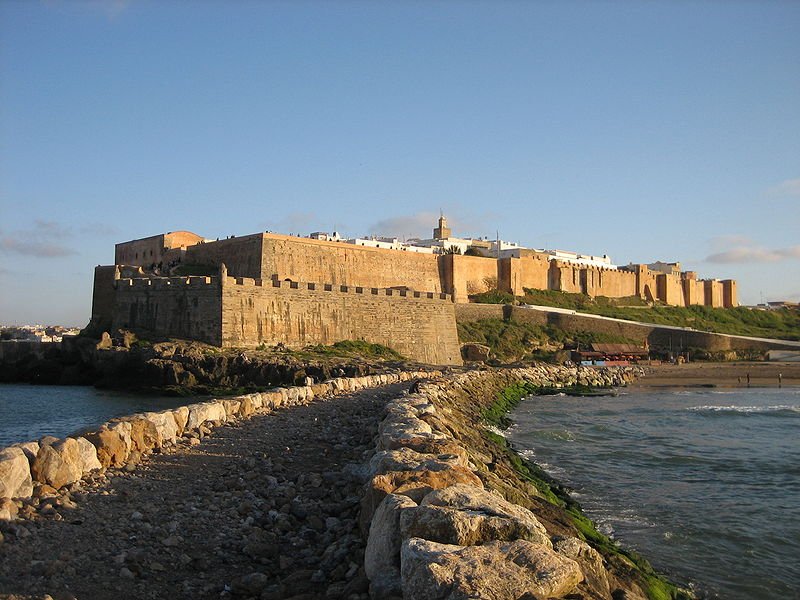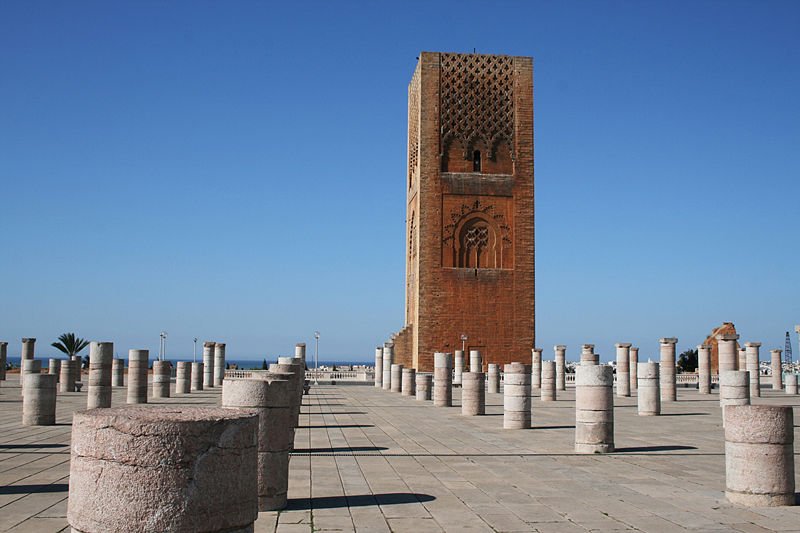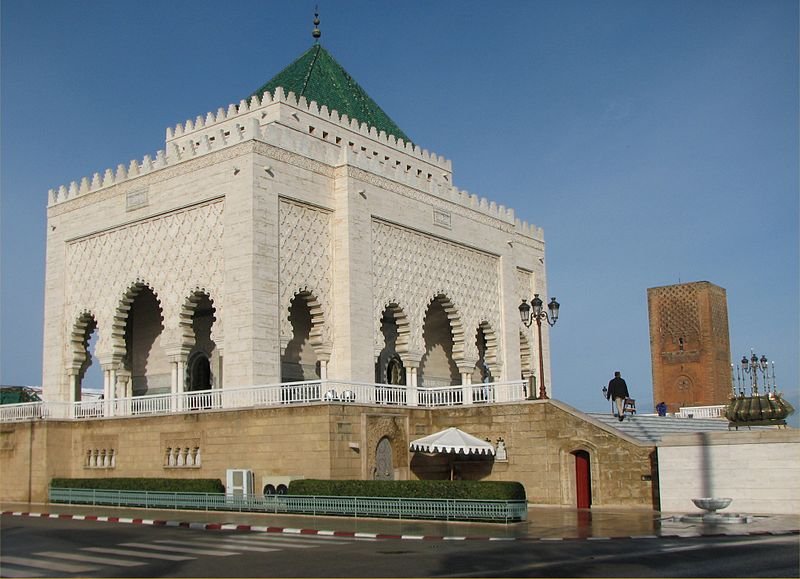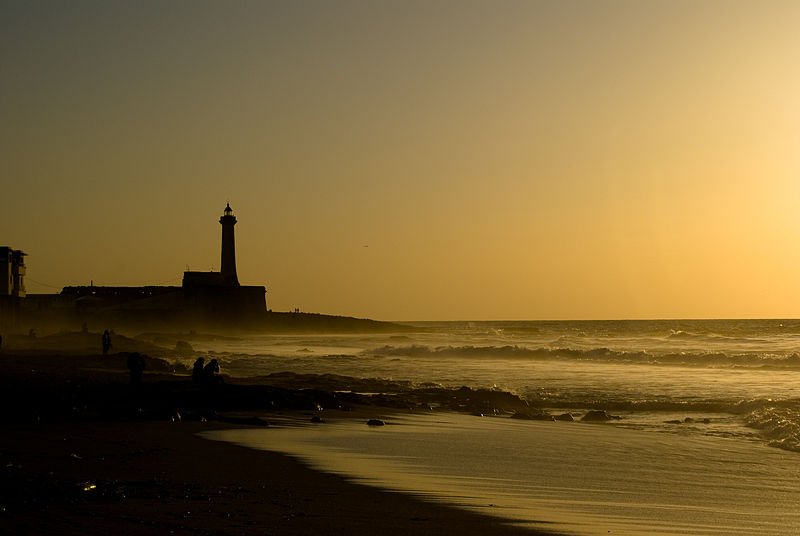
 Oudaïa Kasbah, the citadel of Rabat, Rabat
Oudaïa Kasbah, the citadel of Rabat, Rabat http://commons.wikimedia.org/wiki/File:Kasbah_des_Oudaias_1.jpg
http://commons.wikimedia.org/wiki/File:Kasbah_des_Oudaias_1.jpg Ben Javelina
Ben Javelina
Rabat (الرباط) is the capital and third biggest city in Morocco. It covers 116 sq km (45.17 sq mi) and has a population of 621,000 (2011 estimate) and a metropolitan population of 1.8 million. The city is located at the mouth of the Bou Regreg river facing the Atlantic Ocean. It is one of the four imperial cities of Morocco with Marrakech, Meknes and Fez.
Rabat experiences a Mediterranean climate. Winters are cool while summers warm. Hottest months are July and August, when the average high temperature reaches 27°C (81°F). Coldest month is January, when the average low temperature drops to 7°C (45°F). December is the wettest month with 94 mm (3.7 in) of precipitation.
Rabat traces its history of a settlement, called Chellah, established in the 3rd century BC. It was conquered by the Romans in AD 40 and called Sala Colonia. By AD 250, the Romans have abandoned the area, and it reverted to local rule. In 1146 the Almohad ruler Abd al-Mumin built a fortress here and used it as a launch pad for attacking Spain. It eventually acquired the name Ribatu I-Fath, meaning "fortress of victory", and this was how the name Rabat came about.
 Hassan Tower, with remains of Hassan Mosque in the foreground, Rabat
Hassan Tower, with remains of Hassan Mosque in the foreground, Rabat http://commons.wikimedia.org/wiki/File:Rabat_Tour_Hassan.jpg
http://commons.wikimedia.org/wiki/File:Rabat_Tour_Hassan.jpg Remi Jouan
Remi Jouan
 Mausoleum of Mohammed V, Rabat
Mausoleum of Mohammed V, Rabat http://commons.wikimedia.org/wiki/File:Marokko_011.jpg
http://commons.wikimedia.org/wiki/File:Marokko_011.jpg Olavfin
Olavfin
Rabat came under French occupation in 1912. The French under General Hubert Lyautey built a new town with French-style boulevards as the colonial administrative center. Sultan Moulay Youssef relocated his residence from Fez to Rabat and the capital of Morocco remained there following the country's independence in 1956.
Visiting Rabat
Rabat's airport has limited international connection, so most foreign visitors reach the city by train from Marrakesh, which is four hours away. Fez is just two and a half hours from Rabat while Casablanca is 3 and a half hours away. Rabat lighthouse
Rabat lighthouse http://commons.wikimedia.org/wiki/File:The_Lighthouse_of_Rabat.jpg
http://commons.wikimedia.org/wiki/File:The_Lighthouse_of_Rabat.jpg Jamie Fehr
Jamie Fehr
Places of Interest in Rabat
- Andalusian Wall
Defensive wall built in the 17th century by the Moriscos to provide better defence to the medina. - Bab er-Rouah
Literally the Gate of the Winds, this is a Almohad-style gateway decorated with the outline of two horseshoe arches. - Bab Oudaïa
Monumental city gate that provides the main entrance to the kasbah, one of the finest examples of Almohad architecture. - Cathédrale Saint-Pierre
A white-washed cathedral built in the 1930s in the Ville Nouvelle. - Chellah Necropolis
Ancient burial place dating to the 13th century, entered through an imposing Almohad gate. - Dar el-Makhzen
The royal palace of Morocco, built in the 18th century, is a vast complex housing Moroccan government offices, the Supreme Court, prime minister's office and other civic buildings. - Hassan Tower
One of Rabat's most majestic landmarks, the Hassan Tower commands a hill-top position overlooking Wadi Bou Regreg. - Mausoleum of Mohammed V
Majestic mausoleum to Morocco's Father of Independence. - Musée Archéologique
Museum exhibiting the most extensive collection of Morocco's archaeological artifacts. - Musée de la Monnaie
Coin museum housed in the Bank of Morocco, in the Ville Nouvelle. - Musée des Oudaïa
Museum housed in the former residence and Rabat base of the first Alaouite sultans, built by Moulay Ismaïl in the 17th century. - Oudaïa Kasbah
Also written as Kasbah of the Udayas, this is the medieval citadel built by the Oudaïa, an Arab tribe that was settled in Rabat by Moulay Ismaïl to defend the city. - Place Souk el-Ghezel
Literally the Wool Market Square, this is today a bazaar with fine carpets auctioned here on Thursday mornings. - Rabat City Walls
Medieval walls mostly built by the Almohads in the 12th century, and remodelled and restored in the 17th and 18th centuries by the Moriscos. - Rue des Consuls
Inner city street leading from Place Souk el-Ghezel in the north to the Andalusian Wall in the south. - Rue Hadj Daoui
Inner city street leading from Place Souk el-Ghezel to the living quarters of the medina. - Rue Souïka
Main passageway through Rabat's medina, lined with the liveliest shops. - Rue Souk es-Sebat
Inner city street running from the Great Mosque to Bab el-Bhar (Gate of the Sea). - Ville Nouvelle
New town built by General Hubert Lyautey after a French protectorate was established in 1912.
 Latest updates on Penang Travel Tips
Latest updates on Penang Travel Tips
About this website

Dear visitor, thank you so much for reading this page. My name is Timothy Tye and my hobby is to find out about places, write about them and share the information with you on this website. I have been writing this site since 5 January 2003. Originally (from 2003 until 2009, the site was called AsiaExplorers. I changed the name to Penang Travel Tips in 2009, even though I describe more than just Penang but everywhere I go (I often need to tell people that "Penang Travel Tips" is not just information about Penang, but information written in Penang), especially places in Malaysia and Singapore, and in all the years since 2003, I have described over 20,000 places.
While I try my best to provide you information as accurate as I can get it to be, I do apologize for any errors and for outdated information which I am unaware. Nevertheless, I hope that what I have described here will be useful to you.
To get to know me better, do follow me on Facebook!
Copyright © 2003-2025 Timothy Tye. All Rights Reserved.

 Go Back
Go Back